Open in Colab: https://colab.research.google.com/github/casangi/cngi_prototype/blob/master/docs/imaging/continuum_imaging_example.ipynb
Continuum Imaging¶
This notebook will demonstrate how to create a continuum dirty image with natural weighting using ngCASA. The resulting image will be compared with an image created by CASA.
For this demonstration data from the ALMA First Look at Imaging CASAguide (https://casaguides.nrao.edu/index.php/First_Look_at_Imaging) will be used. The measurement set has been converted to vis.zarr (using convert_ms in cngi.conversion)
This walkthrough is designed to be run in a Jupyter notebook on Google Colaboratory. To open the notebook in colab, go here.
Installation and Dataset Download¶
[1]:
import os
os.system("pip install cngi-prototype==0.0.91")
!gdown -q --id 1PNL0ANqnN7eyYOpQ_vMslQlorUhtrUmE
!unzip sis14_twhya_field_5_lsrk_pol_xx.vis.zarr.zip > /dev/null
!gdown -q --id 19VlXp9Qyx60ld0rBSAYMVFTq5Y1KuxO8
!unzip casa_twhya_standard_gridder_lsrk_mfs_natural.img.zarr.zip > /dev/null
%matplotlib widget
print('complete')
complete
Load Dataset¶
Two datasets are are needed for this notebook sis14_twhya_field_5_lsrk_pol_xx.vis.zarr and casa_twhya_standard_gridder_lsrk_mfs_natural.img.zarr (for more information about the img.zarr format go here and for the vis.zarr format go here).
The sis14_twhya_field_5_lsrk_pol_xx.vis.zarr dataset is used to create a continuum image. The dataset was created by using the mstransform command in CASA
mstransform('sis14_twhya_calibrated_flagged.ms',
outputvis='sis14_twhya_field_5_lsrk_pol_xx.ms',
regridms=True, outframe='LSRK', datacolumn='data',
correlation='XX',field='5')
and then convert_ms in cngi.conversion
infile = 'sis14_twhya_field_5_lsrk_pol_xx.ms'
outfile = 'sis14_twhya_field_5_lsrk_pol_xx.vis.zarr'
chunk_shape=(270, 210, 12, 1)
convert_ms(infile, outfile=outfile , chunk_shape=chunk_shape)
The conversion to ‘LSRK’ is necessary because cngi does not currently have an implementation and tclean does a conversion to ‘LSRK’ before imaging.
To check the ngcasa imaging results the casa_twhya_standard_gridder_lsrk_mfs_natural.img.zarr dataset is used. This dataset was generated by running tclean in CASA
tclean(vis='sis14_twhya_field_5_lsrk_pol_xx.ms',
imagename='twhya_standard_gridder_lsrk_mfs_natural',
specmode='mfs',
deconvolver='hogbom',
imsize=[200,400],
cell=['0.08arcsec'],
weighting='natural',
threshold='0mJy',
niter=0,stokes='XX')
and then image_ms in cngi.conversion
infile = 'twhya_standard_gridder_lsrk_mfs_natural.image'
outfile = 'casa_twhya_standard_gridder_lsrk_mfs_natural.img.zarr'
convert_image(infile=infile,outfile=outfile)
[2]:
import xarray as xr
from cngi.dio import read_vis, read_image
xr.set_options(display_style="html")
mxds = read_vis("sis14_twhya_field_5_lsrk_pol_xx.vis.zarr",chunks={'chan':192})
mxds.xds0
overwrite_encoded_chunks True
[2]:
<xarray.Dataset>
Dimensions: (baseline: 210, chan: 384, pol: 1, pol_id: 1, spw_id: 1, time: 270, uvw_index: 3)
Coordinates:
* baseline (baseline) int64 0 1 2 3 4 5 6 ... 204 205 206 207 208 209
* chan (chan) float64 3.725e+11 3.725e+11 ... 3.728e+11 3.728e+11
chan_width (chan) float64 dask.array<chunksize=(192,), meta=np.ndarray>
effective_bw (chan) float64 dask.array<chunksize=(192,), meta=np.ndarray>
* pol (pol) int32 9
* pol_id (pol_id) int32 0
resolution (chan) float64 dask.array<chunksize=(192,), meta=np.ndarray>
* spw_id (spw_id) int32 0
* time (time) datetime64[ns] 2012-11-19T07:56:26.544000626 ... 2...
Dimensions without coordinates: uvw_index
Data variables: (12/17)
ANTENNA1 (baseline) int32 dask.array<chunksize=(210,), meta=np.ndarray>
ANTENNA2 (baseline) int32 dask.array<chunksize=(210,), meta=np.ndarray>
ARRAY_ID (time, baseline) int32 dask.array<chunksize=(270, 210), meta=np.ndarray>
DATA (time, baseline, chan, pol) complex128 dask.array<chunksize=(270, 210, 192, 1), meta=np.ndarray>
DATA_WEIGHT (time, baseline, chan, pol) float64 dask.array<chunksize=(270, 210, 192, 1), meta=np.ndarray>
EXPOSURE (time, baseline) float64 dask.array<chunksize=(270, 210), meta=np.ndarray>
... ...
OBSERVATION_ID (time, baseline) int32 dask.array<chunksize=(270, 210), meta=np.ndarray>
PROCESSOR_ID (time, baseline) int32 dask.array<chunksize=(270, 210), meta=np.ndarray>
SCAN_NUMBER (time, baseline) int32 dask.array<chunksize=(270, 210), meta=np.ndarray>
STATE_ID (time, baseline) int32 dask.array<chunksize=(270, 210), meta=np.ndarray>
TIME_CENTROID (time, baseline) float64 dask.array<chunksize=(270, 210), meta=np.ndarray>
UVW (time, baseline, uvw_index) float64 dask.array<chunksize=(270, 210, 3), meta=np.ndarray>
Attributes: (12/13)
bbc_no: 2
corr_product: [[0, 0]]
data_groups: [{'0': {'data': 'DATA', 'flag': 'FLAG', 'id': '0', 'uvw...
freq_group: 0
freq_group_name:
if_conv_chain: 0
... ...
name: ALMA_RB_07#BB_2#SW-01#FULL_RES
net_sideband: 2
num_chan: 384
num_corr: 1
ref_frequency: 372520022603.63745
total_bandwidth: 234366781.0546875- baseline: 210
- chan: 384
- pol: 1
- pol_id: 1
- spw_id: 1
- time: 270
- uvw_index: 3
- baseline(baseline)int640 1 2 3 4 5 ... 205 206 207 208 209
array([ 0, 1, 2, ..., 207, 208, 209])
- chan(chan)float643.725e+11 3.725e+11 ... 3.728e+11
array([3.725200e+11, 3.725206e+11, 3.725212e+11, ..., 3.727526e+11, 3.727532e+11, 3.727538e+11]) - chan_width(chan)float64dask.array<chunksize=(192,), meta=np.ndarray>
Array Chunk Bytes 3.00 kiB 1.50 kiB Shape (384,) (192,) Count 3 Tasks 2 Chunks Type float64 numpy.ndarray - effective_bw(chan)float64dask.array<chunksize=(192,), meta=np.ndarray>
Array Chunk Bytes 3.00 kiB 1.50 kiB Shape (384,) (192,) Count 3 Tasks 2 Chunks Type float64 numpy.ndarray - pol(pol)int329
array([9], dtype=int32)
- pol_id(pol_id)int320
array([0], dtype=int32)
- resolution(chan)float64dask.array<chunksize=(192,), meta=np.ndarray>
Array Chunk Bytes 3.00 kiB 1.50 kiB Shape (384,) (192,) Count 3 Tasks 2 Chunks Type float64 numpy.ndarray - spw_id(spw_id)int320
array([0], dtype=int32)
- time(time)datetime64[ns]2012-11-19T07:56:26.544000626 .....
array(['2012-11-19T07:56:26.544000626', '2012-11-19T07:56:32.592000008', '2012-11-19T07:56:38.640000343', ..., '2012-11-19T09:07:16.512000082', '2012-11-19T09:07:22.560000420', '2012-11-19T09:07:28.607999802'], dtype='datetime64[ns]')
- ANTENNA1(baseline)int32dask.array<chunksize=(210,), meta=np.ndarray>
Array Chunk Bytes 840 B 840 B Shape (210,) (210,) Count 2 Tasks 1 Chunks Type int32 numpy.ndarray - ANTENNA2(baseline)int32dask.array<chunksize=(210,), meta=np.ndarray>
Array Chunk Bytes 840 B 840 B Shape (210,) (210,) Count 2 Tasks 1 Chunks Type int32 numpy.ndarray - ARRAY_ID(time, baseline)int32dask.array<chunksize=(270, 210), meta=np.ndarray>
Array Chunk Bytes 221.48 kiB 221.48 kiB Shape (270, 210) (270, 210) Count 2 Tasks 1 Chunks Type int32 numpy.ndarray - DATA(time, baseline, chan, pol)complex128dask.array<chunksize=(270, 210, 192, 1), meta=np.ndarray>
Array Chunk Bytes 332.23 MiB 166.11 MiB Shape (270, 210, 384, 1) (270, 210, 192, 1) Count 3 Tasks 2 Chunks Type complex128 numpy.ndarray - DATA_WEIGHT(time, baseline, chan, pol)float64dask.array<chunksize=(270, 210, 192, 1), meta=np.ndarray>
Array Chunk Bytes 166.11 MiB 83.06 MiB Shape (270, 210, 384, 1) (270, 210, 192, 1) Count 3 Tasks 2 Chunks Type float64 numpy.ndarray - EXPOSURE(time, baseline)float64dask.array<chunksize=(270, 210), meta=np.ndarray>
Array Chunk Bytes 442.97 kiB 442.97 kiB Shape (270, 210) (270, 210) Count 2 Tasks 1 Chunks Type float64 numpy.ndarray - FEED1(time, baseline)int32dask.array<chunksize=(270, 210), meta=np.ndarray>
Array Chunk Bytes 221.48 kiB 221.48 kiB Shape (270, 210) (270, 210) Count 2 Tasks 1 Chunks Type int32 numpy.ndarray - FEED2(time, baseline)int32dask.array<chunksize=(270, 210), meta=np.ndarray>
Array Chunk Bytes 221.48 kiB 221.48 kiB Shape (270, 210) (270, 210) Count 2 Tasks 1 Chunks Type int32 numpy.ndarray - FIELD_ID(time, baseline)int32dask.array<chunksize=(270, 210), meta=np.ndarray>
Array Chunk Bytes 221.48 kiB 221.48 kiB Shape (270, 210) (270, 210) Count 2 Tasks 1 Chunks Type int32 numpy.ndarray - FLAG(time, baseline, chan, pol)booldask.array<chunksize=(270, 210, 192, 1), meta=np.ndarray>
Array Chunk Bytes 20.76 MiB 10.38 MiB Shape (270, 210, 384, 1) (270, 210, 192, 1) Count 3 Tasks 2 Chunks Type bool numpy.ndarray - INTERVAL(time, baseline)float64dask.array<chunksize=(270, 210), meta=np.ndarray>
Array Chunk Bytes 442.97 kiB 442.97 kiB Shape (270, 210) (270, 210) Count 2 Tasks 1 Chunks Type float64 numpy.ndarray - OBSERVATION_ID(time, baseline)int32dask.array<chunksize=(270, 210), meta=np.ndarray>
Array Chunk Bytes 221.48 kiB 221.48 kiB Shape (270, 210) (270, 210) Count 2 Tasks 1 Chunks Type int32 numpy.ndarray - PROCESSOR_ID(time, baseline)int32dask.array<chunksize=(270, 210), meta=np.ndarray>
Array Chunk Bytes 221.48 kiB 221.48 kiB Shape (270, 210) (270, 210) Count 2 Tasks 1 Chunks Type int32 numpy.ndarray - SCAN_NUMBER(time, baseline)int32dask.array<chunksize=(270, 210), meta=np.ndarray>
Array Chunk Bytes 221.48 kiB 221.48 kiB Shape (270, 210) (270, 210) Count 2 Tasks 1 Chunks Type int32 numpy.ndarray - STATE_ID(time, baseline)int32dask.array<chunksize=(270, 210), meta=np.ndarray>
Array Chunk Bytes 221.48 kiB 221.48 kiB Shape (270, 210) (270, 210) Count 2 Tasks 1 Chunks Type int32 numpy.ndarray - TIME_CENTROID(time, baseline)float64dask.array<chunksize=(270, 210), meta=np.ndarray>
Array Chunk Bytes 442.97 kiB 442.97 kiB Shape (270, 210) (270, 210) Count 2 Tasks 1 Chunks Type float64 numpy.ndarray - UVW(time, baseline, uvw_index)float64dask.array<chunksize=(270, 210, 3), meta=np.ndarray>
Array Chunk Bytes 1.30 MiB 1.30 MiB Shape (270, 210, 3) (270, 210, 3) Count 2 Tasks 1 Chunks Type float64 numpy.ndarray
- bbc_no :
- 2
- corr_product :
- [[0, 0]]
- data_groups :
- [{'0': {'data': 'DATA', 'flag': 'FLAG', 'id': '0', 'uvw': 'UVW', 'weight': 'DATA_WEIGHT'}}]
- freq_group :
- 0
- freq_group_name :
- if_conv_chain :
- 0
- meas_freq_ref :
- 1
- name :
- ALMA_RB_07#BB_2#SW-01#FULL_RES
- net_sideband :
- 2
- num_chan :
- 384
- num_corr :
- 1
- ref_frequency :
- 372520022603.63745
- total_bandwidth :
- 234366781.0546875
Note that the chunks parameter in cngi and ngcasa functions specifies the size of a chunk and not the number of chunks (in CASA tclean chanchunks refers to the number of channel chunks).
The dimensionality of the sis14_twhya_field_5_lsrk_pol_xx.vis.zarr dataset is (time:270,baseline:210,chan:384,pol:1) and a zarr chunk size of (time:270,baseline:210,chan:12,pol:1) was chosen. With the cngi.dio.read_vis function the dask chunk size was set to (time:270,baseline:210,chan:192,pol:1). For more information concerning chunking go here.
Flag Data and Create Imaging Weights¶
The apply_flags cngi.vis function sets all values that should be flagged to nan. The ngcasa.imaging code does not internally apply flags but does ignore nan values. apply_flags documentation
The make_imaging_weight cngi.imaging function takes the WEIGHT data variables and creates IMAGING_WEIGHT data variable that has dimensions time x baseline x chan x pol (matches the visibility DATA variable). Weighting schemes that are supported include natural, uniform, briggs, briggs_abs. make_imaging_weight documentation
[3]:
from cngi.vis import apply_flags
from ngcasa.imaging import make_imaging_weight
mxds = apply_flags(mxds, 'xds0', flags='FLAG')
imaging_weights_parms = {}
imaging_weights_parms['weighting'] = 'natural'
sel_parms = {}
sel_parms['xds'] = 'xds0'
sel_parms['data_group_in_id'] = 0
grid_parms = {}
grid_parms['chan_mode'] = 'continuum'
grid_parms['image_size'] = [200,400]
grid_parms['cell_size'] = [0.08,0.08]
mxds = make_imaging_weight(mxds, imaging_weights_parms, grid_parms, sel_parms)
mxds.xds0
######################### Start make_imaging_weights #########################
Setting data_group_in to {'data': 'DATA', 'flag': 'FLAG', 'id': '0', 'uvw': 'UVW', 'weight': 'DATA_WEIGHT'}
Setting default data_group_out to {'data': 'DATA', 'flag': 'FLAG', 'id': '0', 'uvw': 'UVW', 'weight': 'DATA_WEIGHT', 'imaging_weight': 'IMAGING_WEIGHT'}
Since weighting is natural input weight will be reused as imaging weight.
######################### Created graph for make_imaging_weight #########################
[3]:
<xarray.Dataset>
Dimensions: (baseline: 210, chan: 384, pol: 1, pol_id: 1, spw_id: 1, time: 270, uvw_index: 3)
Coordinates:
* baseline (baseline) int64 0 1 2 3 4 5 6 ... 204 205 206 207 208 209
* chan (chan) float64 3.725e+11 3.725e+11 ... 3.728e+11 3.728e+11
chan_width (chan) float64 dask.array<chunksize=(192,), meta=np.ndarray>
effective_bw (chan) float64 dask.array<chunksize=(192,), meta=np.ndarray>
* pol (pol) int32 9
* pol_id (pol_id) int32 0
resolution (chan) float64 dask.array<chunksize=(192,), meta=np.ndarray>
* spw_id (spw_id) int32 0
* time (time) datetime64[ns] 2012-11-19T07:56:26.544000626 ... 2...
Dimensions without coordinates: uvw_index
Data variables: (12/17)
ANTENNA1 (baseline) int32 dask.array<chunksize=(210,), meta=np.ndarray>
ANTENNA2 (baseline) int32 dask.array<chunksize=(210,), meta=np.ndarray>
ARRAY_ID (time, baseline) int32 dask.array<chunksize=(270, 210), meta=np.ndarray>
DATA (time, baseline, chan, pol) complex128 dask.array<chunksize=(270, 210, 192, 1), meta=np.ndarray>
DATA_WEIGHT (time, baseline, chan, pol) float64 dask.array<chunksize=(270, 210, 192, 1), meta=np.ndarray>
EXPOSURE (time, baseline) float64 dask.array<chunksize=(270, 210), meta=np.ndarray>
... ...
OBSERVATION_ID (time, baseline) int32 dask.array<chunksize=(270, 210), meta=np.ndarray>
PROCESSOR_ID (time, baseline) int32 dask.array<chunksize=(270, 210), meta=np.ndarray>
SCAN_NUMBER (time, baseline) int32 dask.array<chunksize=(270, 210), meta=np.ndarray>
STATE_ID (time, baseline) int32 dask.array<chunksize=(270, 210), meta=np.ndarray>
TIME_CENTROID (time, baseline) float64 dask.array<chunksize=(270, 210), meta=np.ndarray>
UVW (time, baseline, uvw_index) float64 dask.array<chunksize=(270, 210, 3), meta=np.ndarray>
Attributes: (12/13)
bbc_no: 2
corr_product: [[0, 0]]
data_groups: [{'0': {'data': 'DATA', 'flag': 'FLAG', 'id': '0', 'uvw...
freq_group: 0
freq_group_name:
if_conv_chain: 0
... ...
name: ALMA_RB_07#BB_2#SW-01#FULL_RES
net_sideband: 2
num_chan: 384
num_corr: 1
ref_frequency: 372520022603.63745
total_bandwidth: 234366781.0546875- baseline: 210
- chan: 384
- pol: 1
- pol_id: 1
- spw_id: 1
- time: 270
- uvw_index: 3
- baseline(baseline)int640 1 2 3 4 5 ... 205 206 207 208 209
array([ 0, 1, 2, ..., 207, 208, 209])
- chan(chan)float643.725e+11 3.725e+11 ... 3.728e+11
array([3.725200e+11, 3.725206e+11, 3.725212e+11, ..., 3.727526e+11, 3.727532e+11, 3.727538e+11]) - chan_width(chan)float64dask.array<chunksize=(192,), meta=np.ndarray>
Array Chunk Bytes 3.00 kiB 1.50 kiB Shape (384,) (192,) Count 3 Tasks 2 Chunks Type float64 numpy.ndarray - effective_bw(chan)float64dask.array<chunksize=(192,), meta=np.ndarray>
Array Chunk Bytes 3.00 kiB 1.50 kiB Shape (384,) (192,) Count 3 Tasks 2 Chunks Type float64 numpy.ndarray - pol(pol)int329
array([9], dtype=int32)
- pol_id(pol_id)int320
array([0], dtype=int32)
- resolution(chan)float64dask.array<chunksize=(192,), meta=np.ndarray>
Array Chunk Bytes 3.00 kiB 1.50 kiB Shape (384,) (192,) Count 3 Tasks 2 Chunks Type float64 numpy.ndarray - spw_id(spw_id)int320
array([0], dtype=int32)
- time(time)datetime64[ns]2012-11-19T07:56:26.544000626 .....
array(['2012-11-19T07:56:26.544000626', '2012-11-19T07:56:32.592000008', '2012-11-19T07:56:38.640000343', ..., '2012-11-19T09:07:16.512000082', '2012-11-19T09:07:22.560000420', '2012-11-19T09:07:28.607999802'], dtype='datetime64[ns]')
- ANTENNA1(baseline)int32dask.array<chunksize=(210,), meta=np.ndarray>
Array Chunk Bytes 840 B 840 B Shape (210,) (210,) Count 3 Tasks 1 Chunks Type int32 numpy.ndarray - ANTENNA2(baseline)int32dask.array<chunksize=(210,), meta=np.ndarray>
Array Chunk Bytes 840 B 840 B Shape (210,) (210,) Count 3 Tasks 1 Chunks Type int32 numpy.ndarray - ARRAY_ID(time, baseline)int32dask.array<chunksize=(270, 210), meta=np.ndarray>
Array Chunk Bytes 221.48 kiB 221.48 kiB Shape (270, 210) (270, 210) Count 3 Tasks 1 Chunks Type int32 numpy.ndarray - DATA(time, baseline, chan, pol)complex128dask.array<chunksize=(270, 210, 192, 1), meta=np.ndarray>
Array Chunk Bytes 332.23 MiB 166.11 MiB Shape (270, 210, 384, 1) (270, 210, 192, 1) Count 10 Tasks 2 Chunks Type complex128 numpy.ndarray - DATA_WEIGHT(time, baseline, chan, pol)float64dask.array<chunksize=(270, 210, 192, 1), meta=np.ndarray>
Array Chunk Bytes 166.11 MiB 83.06 MiB Shape (270, 210, 384, 1) (270, 210, 192, 1) Count 10 Tasks 2 Chunks Type float64 numpy.ndarray - EXPOSURE(time, baseline)float64dask.array<chunksize=(270, 210), meta=np.ndarray>
Array Chunk Bytes 442.97 kiB 442.97 kiB Shape (270, 210) (270, 210) Count 3 Tasks 1 Chunks Type float64 numpy.ndarray - FEED1(time, baseline)int32dask.array<chunksize=(270, 210), meta=np.ndarray>
Array Chunk Bytes 221.48 kiB 221.48 kiB Shape (270, 210) (270, 210) Count 3 Tasks 1 Chunks Type int32 numpy.ndarray - FEED2(time, baseline)int32dask.array<chunksize=(270, 210), meta=np.ndarray>
Array Chunk Bytes 221.48 kiB 221.48 kiB Shape (270, 210) (270, 210) Count 3 Tasks 1 Chunks Type int32 numpy.ndarray - FIELD_ID(time, baseline)int32dask.array<chunksize=(270, 210), meta=np.ndarray>
Array Chunk Bytes 221.48 kiB 221.48 kiB Shape (270, 210) (270, 210) Count 3 Tasks 1 Chunks Type int32 numpy.ndarray - FLAG(time, baseline, chan, pol)booldask.array<chunksize=(270, 210, 192, 1), meta=np.ndarray>
Array Chunk Bytes 20.76 MiB 10.38 MiB Shape (270, 210, 384, 1) (270, 210, 192, 1) Count 3 Tasks 2 Chunks Type bool numpy.ndarray - INTERVAL(time, baseline)float64dask.array<chunksize=(270, 210), meta=np.ndarray>
Array Chunk Bytes 442.97 kiB 442.97 kiB Shape (270, 210) (270, 210) Count 3 Tasks 1 Chunks Type float64 numpy.ndarray - OBSERVATION_ID(time, baseline)int32dask.array<chunksize=(270, 210), meta=np.ndarray>
Array Chunk Bytes 221.48 kiB 221.48 kiB Shape (270, 210) (270, 210) Count 3 Tasks 1 Chunks Type int32 numpy.ndarray - PROCESSOR_ID(time, baseline)int32dask.array<chunksize=(270, 210), meta=np.ndarray>
Array Chunk Bytes 221.48 kiB 221.48 kiB Shape (270, 210) (270, 210) Count 3 Tasks 1 Chunks Type int32 numpy.ndarray - SCAN_NUMBER(time, baseline)int32dask.array<chunksize=(270, 210), meta=np.ndarray>
Array Chunk Bytes 221.48 kiB 221.48 kiB Shape (270, 210) (270, 210) Count 3 Tasks 1 Chunks Type int32 numpy.ndarray - STATE_ID(time, baseline)int32dask.array<chunksize=(270, 210), meta=np.ndarray>
Array Chunk Bytes 221.48 kiB 221.48 kiB Shape (270, 210) (270, 210) Count 3 Tasks 1 Chunks Type int32 numpy.ndarray - TIME_CENTROID(time, baseline)float64dask.array<chunksize=(270, 210), meta=np.ndarray>
Array Chunk Bytes 442.97 kiB 442.97 kiB Shape (270, 210) (270, 210) Count 3 Tasks 1 Chunks Type float64 numpy.ndarray - UVW(time, baseline, uvw_index)float64dask.array<chunksize=(270, 210, 3), meta=np.ndarray>
Array Chunk Bytes 1.30 MiB 1.30 MiB Shape (270, 210, 3) (270, 210, 3) Count 3 Tasks 1 Chunks Type float64 numpy.ndarray
- bbc_no :
- 2
- corr_product :
- [[0, 0]]
- data_groups :
- [{'0': {'data': 'DATA', 'flag': 'FLAG', 'id': '0', 'uvw': 'UVW', 'weight': 'DATA_WEIGHT', 'imaging_weight': 'DATA_WEIGHT'}}]
- freq_group :
- 0
- freq_group_name :
- if_conv_chain :
- 0
- meas_freq_ref :
- 1
- name :
- ALMA_RB_07#BB_2#SW-01#FULL_RES
- net_sideband :
- 2
- num_chan :
- 384
- num_corr :
- 1
- ref_frequency :
- 372520022603.63745
- total_bandwidth :
- 234366781.0546875
Create Dirty Continuum Image and Primary Beam¶
The make_image cngi.imaging function grids the data (using the prolate spheroidal function as an anti-aliasing filter), fast Fourier transform the gridded data to an image and normalizes the image. The make_pb function currently supports rotationally symmetric airy disk primary beams. The write_zarr function is now used to trigger a compute (which includes applying the flags, creating the imaging weights and making the image).
[4]:
from ngcasa.imaging import make_image
from ngcasa.imaging import make_pb
from cngi.dio import write_image
import dask
grid_parms = {}
grid_parms['chan_mode'] = 'continuum'
grid_parms['image_size'] = [200,400]
grid_parms['cell_size'] = [0.08,0.08]
grid_parms['phase_center'] = mxds.FIELD.PHASE_DIR[0,0,:].data.compute()
vis_sel_parms = {}
vis_sel_parms['xds'] = 'xds0'
vis_sel_parms['data_group_in_id'] = 0
img_sel_parms = {}
img_sel_parms['data_group_out_id'] = 0
img_xds = xr.Dataset() #empty dataset
img_xds = make_image(mxds, img_xds, grid_parms, vis_sel_parms, img_sel_parms)
make_pb_parms = {}
make_pb_parms['function'] = 'casa_airy'
make_pb_parms['list_dish_diameters'] = [10.7]
make_pb_parms['list_blockage_diameters'] = [0.75]
sel_parms = {}
sel_parms['img_description_in_indx'] = 0
img_xds = make_pb(img_xds,make_pb_parms, grid_parms, sel_parms)
img_xds = write_image(img_xds, 'twhya_standard_gridder_lsrk_mfs_natural.img.zarr')
######################### Start make_image #########################
Setting default image_center to [100 200]
Setting default fft_padding to 1.2
Setting data_group_in to {'data': 'DATA', 'flag': 'FLAG', 'id': '0', 'uvw': 'UVW', 'weight': 'DATA_WEIGHT', 'imaging_weight': 'DATA_WEIGHT'}
Setting default data_group_out to {'data': 'DATA', 'flag': 'FLAG', 'id': '1', 'uvw': 'UVW', 'weight': 'DATA_WEIGHT', 'imaging_weight': 'DATA_WEIGHT'}
Setting default data_group_in to {'id': '0'}
Setting default data_group_out [' sum_weight '] to SUM_WEIGHT
Setting default data_group_out [' image '] to IMAGE
######################### Created graph for make_image #########################
######################### Start make_pb #########################
Setting default data_group_in to {'id': '0', 'sum_weight': 'SUM_WEIGHT', 'image': 'IMAGE'}
Setting default data_group_out to {'id': '0', 'sum_weight': 'SUM_WEIGHT', 'image': 'IMAGE', 'pb': 'PB'}
Setting default image_center to [100 200]
Setting default fft_padding to 1.2
######################### Created graph for make_pb #########################
Time to store and execute graph write_zarr 7.705185174942017
[5]:
casa_img_xds = read_image("casa_twhya_standard_gridder_lsrk_mfs_natural.img.zarr")
casa_img_xds
[5]:
<xarray.Dataset>
Dimensions: (chan: 1, l: 200, m: 400, pol: 1, time: 1)
Coordinates:
* chan (chan) float64 3.726e+11
declination (l, m) float64 dask.array<chunksize=(200, 400), meta=np.ndarray>
* l (l) float64 3.879e-05 3.84e-05 ... -3.801e-05 -3.84e-05
* m (m) float64 -7.757e-05 -7.718e-05 ... 7.679e-05 7.718e-05
* pol (pol) float64 9.0
right_ascension (l, m) float64 dask.array<chunksize=(200, 400), meta=np.ndarray>
* time (time) datetime64[ns] 2012-11-19T07:56:26.544000626
Data variables:
IMAGE (l, m, time, chan, pol) float64 dask.array<chunksize=(200, 400, 1, 1, 1), meta=np.ndarray>
IMAGE_MASK0 (l, m, time, chan, pol) bool dask.array<chunksize=(200, 400, 1, 1, 1), meta=np.ndarray>
IMAGE_PBCOR (l, m, time, chan, pol) float64 dask.array<chunksize=(200, 400, 1, 1, 1), meta=np.ndarray>
IMAGE_PBCOR_MASK0 (l, m, time, chan, pol) bool dask.array<chunksize=(200, 400, 1, 1, 1), meta=np.ndarray>
MODEL (l, m, time, chan, pol) float64 dask.array<chunksize=(200, 400, 1, 1, 1), meta=np.ndarray>
PB (l, m, time, chan, pol) float64 dask.array<chunksize=(200, 400, 1, 1, 1), meta=np.ndarray>
PB_MASK0 (l, m, time, chan, pol) bool dask.array<chunksize=(200, 400, 1, 1, 1), meta=np.ndarray>
PSF (l, m, time, chan, pol) float64 dask.array<chunksize=(200, 400, 1, 1, 1), meta=np.ndarray>
RESIDUAL (l, m, time, chan, pol) float64 dask.array<chunksize=(200, 400, 1, 1, 1), meta=np.ndarray>
RESIDUAL_MASK0 (l, m, time, chan, pol) bool dask.array<chunksize=(200, 400, 1, 1, 1), meta=np.ndarray>
SUMWT (time, chan, pol) float64 dask.array<chunksize=(1, 1, 1), meta=np.ndarray>
Attributes: (12/19)
axisnames: ['Right Ascension', 'Declination', 'Time', 'Frequen...
axisunits: ['rad', 'rad', 'datetime64[ns]', 'Hz', '']
commonbeam: [0.6637904644012451, 0.5050938129425049, -65.900085...
commonbeam_units: ['arcsec', 'arcsec', 'deg']
date_observation: 2012/11/19/07
direction_reference: j2000
... ...
restoringbeam: [0.6637904644012451, 0.5050938129425049, -65.900085...
spectral__reference: lsrk
telescope: alma
telescope_position: [2.22514e+06m, -5.44031e+06m, -2.48103e+06m] (itrf)
unit: Jy/beam
velocity__type: radio- chan: 1
- l: 200
- m: 400
- pol: 1
- time: 1
- chan(chan)float643.726e+11
array([3.726369e+11])
- declination(l, m)float64dask.array<chunksize=(200, 400), meta=np.ndarray>
Array Chunk Bytes 625.00 kiB 625.00 kiB Shape (200, 400) (200, 400) Count 2 Tasks 1 Chunks Type float64 numpy.ndarray - l(l)float643.879e-05 3.84e-05 ... -3.84e-05
array([ 3.878509e-05, 3.839724e-05, 3.800939e-05, 3.762154e-05, 3.723369e-05, 3.684584e-05, 3.645799e-05, 3.607014e-05, 3.568229e-05, 3.529444e-05, 3.490659e-05, 3.451873e-05, 3.413088e-05, 3.374303e-05, 3.335518e-05, 3.296733e-05, 3.257948e-05, 3.219163e-05, 3.180378e-05, 3.141593e-05, 3.102808e-05, 3.064022e-05, 3.025237e-05, 2.986452e-05, 2.947667e-05, 2.908882e-05, 2.870097e-05, 2.831312e-05, 2.792527e-05, 2.753742e-05, 2.714957e-05, 2.676172e-05, 2.637386e-05, 2.598601e-05, 2.559816e-05, 2.521031e-05, 2.482246e-05, 2.443461e-05, 2.404676e-05, 2.365891e-05, 2.327106e-05, 2.288321e-05, 2.249535e-05, 2.210750e-05, 2.171965e-05, 2.133180e-05, 2.094395e-05, 2.055610e-05, 2.016825e-05, 1.978040e-05, 1.939255e-05, 1.900470e-05, 1.861685e-05, 1.822899e-05, 1.784114e-05, 1.745329e-05, 1.706544e-05, 1.667759e-05, 1.628974e-05, 1.590189e-05, 1.551404e-05, 1.512619e-05, 1.473834e-05, 1.435048e-05, 1.396263e-05, 1.357478e-05, 1.318693e-05, 1.279908e-05, 1.241123e-05, 1.202338e-05, 1.163553e-05, 1.124768e-05, 1.085983e-05, 1.047198e-05, 1.008412e-05, 9.696274e-06, 9.308423e-06, 8.920572e-06, 8.532721e-06, 8.144870e-06, 7.757019e-06, 7.369168e-06, 6.981317e-06, 6.593466e-06, 6.205615e-06, 5.817764e-06, 5.429913e-06, 5.042062e-06, 4.654211e-06, 4.266360e-06, 3.878509e-06, 3.490659e-06, 3.102808e-06, 2.714957e-06, 2.327106e-06, 1.939255e-06, 1.551404e-06, 1.163553e-06, 7.757019e-07, 3.878509e-07, -0.000000e+00, -3.878509e-07, -7.757019e-07, -1.163553e-06, -1.551404e-06, -1.939255e-06, -2.327106e-06, -2.714957e-06, -3.102808e-06, -3.490659e-06, -3.878509e-06, -4.266360e-06, -4.654211e-06, -5.042062e-06, -5.429913e-06, -5.817764e-06, -6.205615e-06, -6.593466e-06, -6.981317e-06, -7.369168e-06, -7.757019e-06, -8.144870e-06, -8.532721e-06, -8.920572e-06, -9.308423e-06, -9.696274e-06, -1.008412e-05, -1.047198e-05, -1.085983e-05, -1.124768e-05, -1.163553e-05, -1.202338e-05, -1.241123e-05, -1.279908e-05, -1.318693e-05, -1.357478e-05, -1.396263e-05, -1.435048e-05, -1.473834e-05, -1.512619e-05, -1.551404e-05, -1.590189e-05, -1.628974e-05, -1.667759e-05, -1.706544e-05, -1.745329e-05, -1.784114e-05, -1.822899e-05, -1.861685e-05, -1.900470e-05, -1.939255e-05, -1.978040e-05, -2.016825e-05, -2.055610e-05, -2.094395e-05, -2.133180e-05, -2.171965e-05, -2.210750e-05, -2.249535e-05, -2.288321e-05, -2.327106e-05, -2.365891e-05, -2.404676e-05, -2.443461e-05, -2.482246e-05, -2.521031e-05, -2.559816e-05, -2.598601e-05, -2.637386e-05, -2.676172e-05, -2.714957e-05, -2.753742e-05, -2.792527e-05, -2.831312e-05, -2.870097e-05, -2.908882e-05, -2.947667e-05, -2.986452e-05, -3.025237e-05, -3.064022e-05, -3.102808e-05, -3.141593e-05, -3.180378e-05, -3.219163e-05, -3.257948e-05, -3.296733e-05, -3.335518e-05, -3.374303e-05, -3.413088e-05, -3.451873e-05, -3.490659e-05, -3.529444e-05, -3.568229e-05, -3.607014e-05, -3.645799e-05, -3.684584e-05, -3.723369e-05, -3.762154e-05, -3.800939e-05, -3.839724e-05]) - m(m)float64-7.757e-05 -7.718e-05 ... 7.718e-05
array([-7.757019e-05, -7.718234e-05, -7.679449e-05, ..., 7.640664e-05, 7.679449e-05, 7.718234e-05]) - pol(pol)float649.0
array([9.])
- right_ascension(l, m)float64dask.array<chunksize=(200, 400), meta=np.ndarray>
Array Chunk Bytes 625.00 kiB 625.00 kiB Shape (200, 400) (200, 400) Count 2 Tasks 1 Chunks Type float64 numpy.ndarray - time(time)datetime64[ns]2012-11-19T07:56:26.544000626
array(['2012-11-19T07:56:26.544000626'], dtype='datetime64[ns]')
- IMAGE(l, m, time, chan, pol)float64dask.array<chunksize=(200, 400, 1, 1, 1), meta=np.ndarray>
Array Chunk Bytes 625.00 kiB 625.00 kiB Shape (200, 400, 1, 1, 1) (200, 400, 1, 1, 1) Count 2 Tasks 1 Chunks Type float64 numpy.ndarray - IMAGE_MASK0(l, m, time, chan, pol)booldask.array<chunksize=(200, 400, 1, 1, 1), meta=np.ndarray>
Array Chunk Bytes 78.12 kiB 78.12 kiB Shape (200, 400, 1, 1, 1) (200, 400, 1, 1, 1) Count 2 Tasks 1 Chunks Type bool numpy.ndarray - IMAGE_PBCOR(l, m, time, chan, pol)float64dask.array<chunksize=(200, 400, 1, 1, 1), meta=np.ndarray>
Array Chunk Bytes 625.00 kiB 625.00 kiB Shape (200, 400, 1, 1, 1) (200, 400, 1, 1, 1) Count 2 Tasks 1 Chunks Type float64 numpy.ndarray - IMAGE_PBCOR_MASK0(l, m, time, chan, pol)booldask.array<chunksize=(200, 400, 1, 1, 1), meta=np.ndarray>
Array Chunk Bytes 78.12 kiB 78.12 kiB Shape (200, 400, 1, 1, 1) (200, 400, 1, 1, 1) Count 2 Tasks 1 Chunks Type bool numpy.ndarray - MODEL(l, m, time, chan, pol)float64dask.array<chunksize=(200, 400, 1, 1, 1), meta=np.ndarray>
Array Chunk Bytes 625.00 kiB 625.00 kiB Shape (200, 400, 1, 1, 1) (200, 400, 1, 1, 1) Count 2 Tasks 1 Chunks Type float64 numpy.ndarray - PB(l, m, time, chan, pol)float64dask.array<chunksize=(200, 400, 1, 1, 1), meta=np.ndarray>
Array Chunk Bytes 625.00 kiB 625.00 kiB Shape (200, 400, 1, 1, 1) (200, 400, 1, 1, 1) Count 2 Tasks 1 Chunks Type float64 numpy.ndarray - PB_MASK0(l, m, time, chan, pol)booldask.array<chunksize=(200, 400, 1, 1, 1), meta=np.ndarray>
Array Chunk Bytes 78.12 kiB 78.12 kiB Shape (200, 400, 1, 1, 1) (200, 400, 1, 1, 1) Count 2 Tasks 1 Chunks Type bool numpy.ndarray - PSF(l, m, time, chan, pol)float64dask.array<chunksize=(200, 400, 1, 1, 1), meta=np.ndarray>
Array Chunk Bytes 625.00 kiB 625.00 kiB Shape (200, 400, 1, 1, 1) (200, 400, 1, 1, 1) Count 2 Tasks 1 Chunks Type float64 numpy.ndarray - RESIDUAL(l, m, time, chan, pol)float64dask.array<chunksize=(200, 400, 1, 1, 1), meta=np.ndarray>
Array Chunk Bytes 625.00 kiB 625.00 kiB Shape (200, 400, 1, 1, 1) (200, 400, 1, 1, 1) Count 2 Tasks 1 Chunks Type float64 numpy.ndarray - RESIDUAL_MASK0(l, m, time, chan, pol)booldask.array<chunksize=(200, 400, 1, 1, 1), meta=np.ndarray>
Array Chunk Bytes 78.12 kiB 78.12 kiB Shape (200, 400, 1, 1, 1) (200, 400, 1, 1, 1) Count 2 Tasks 1 Chunks Type bool numpy.ndarray - SUMWT(time, chan, pol)float64dask.array<chunksize=(1, 1, 1), meta=np.ndarray>
Array Chunk Bytes 8 B 8 B Shape (1, 1, 1) (1, 1, 1) Count 2 Tasks 1 Chunks Type float64 numpy.ndarray
- axisnames :
- ['Right Ascension', 'Declination', 'Time', 'Frequency', 'Stokes']
- axisunits :
- ['rad', 'rad', 'datetime64[ns]', 'Hz', '']
- commonbeam :
- [0.6637904644012451, 0.5050938129425049, -65.90008544921875]
- commonbeam_units :
- ['arcsec', 'arcsec', 'deg']
- date_observation :
- 2012/11/19/07
- direction_reference :
- j2000
- imagetype :
- Intensity
- incr :
- [-3.878509448876288e-07, 3.878509448876288e-07, 1.0, 234366781.0546875]
- object_name :
- tw hya
- observer :
- cqi
- pointing_center :
- 11
- rest_frequency :
- 3.72637e+11 hz
- restoring_beam :
- 0.66379 arcsec, 0.505094 arcsec, -65.9001 deg
- restoringbeam :
- [0.6637904644012451, 0.5050938129425049, -65.90008544921875]
- spectral__reference :
- lsrk
- telescope :
- alma
- telescope_position :
- [2.22514e+06m, -5.44031e+06m, -2.48103e+06m] (itrf)
- unit :
- Jy/beam
- velocity__type :
- radio
Plot and Compare With CASA¶
[6]:
import matplotlib.pylab as plt
import numpy as np
img_xds = read_image("twhya_standard_gridder_lsrk_mfs_natural.img.zarr")
casa_img_xds = read_image("casa_twhya_standard_gridder_lsrk_mfs_natural.img.zarr")
plt.close('all')
#### Compare dirty images ####
dirty_image = img_xds['IMAGE'].isel(chan=0,time=0,pol=0) #Image created by ngCASA
casa_dirty_image = casa_img_xds['RESIDUAL'].isel(chan=0,time=0,pol=0) #Image created by CASA
#Plotting Images
minmin = np.min([np.min(casa_dirty_image.data), np.min(dirty_image.data)])
maxmax = np.max([np.max(casa_dirty_image.data), np.max(dirty_image.data)])
extent = extent=(np.min(casa_dirty_image.m),np.max(casa_dirty_image.m),np.min(casa_dirty_image.l),np.max(casa_dirty_image.l))
fig0, ax0 = plt.subplots(1, 2, sharey=True,figsize=(10, 5))
im0 = ax0[0].imshow(casa_dirty_image,extent=extent)
im1 = ax0[1].imshow(dirty_image,extent=extent)
ax0[0].title.set_text('CASA Dirty Image')
ax0[1].title.set_text('ngCASA Dirty Image')
ax0[0].set_xlabel('m')
ax0[1].set_xlabel('m')
ax0[0].set_ylabel('l')
ax0[1].set_ylabel('l')
fig0.colorbar(im0, ax=ax0[0], fraction=0.046, pad=0.04)
fig0.colorbar(im1, ax=ax0[1], fraction=0.046, pad=0.04)
plt.show()
dif_image = casa_dirty_image - dirty_image
plt.figure()
plt.imshow(dif_image,extent=extent)
plt.title('Difference Dirty Image')
plt.xlabel('m')
plt.ylabel('l')
plt.colorbar(fraction=0.046, pad=0.04)
plt.show()
dirty_image = dirty_image / np.max(np.abs(dirty_image))
casa_dirty_image = casa_dirty_image / np.max(np.abs(casa_dirty_image))
# Calculate max error
max_error_dirty_image = np.max(np.abs(dirty_image - casa_dirty_image)).values
print('Max Error',max_error_dirty_image)
# Calculate root mean square error
rms_error_dirty_image = np.linalg.norm(dirty_image - casa_dirty_image, 'fro')
print('RMS Error',rms_error_dirty_image)
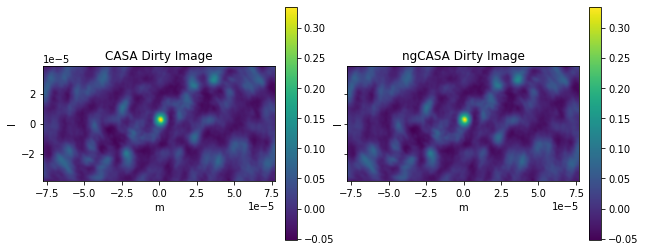
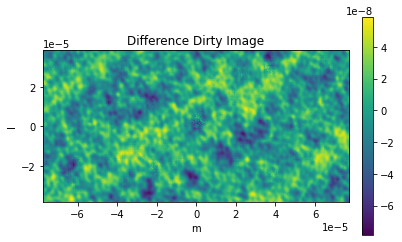
Max Error 2.2810074962187343e-07
RMS Error 1.6647486690733482e-05
The reason for the small difference between ngCASA and CASA is due to ngCASA using a different implementation of the Fast Fourier Transform.
[7]:
import matplotlib.pylab as plt
import numpy as np
import xarray as xr
import dask.array as da
import dask
from cngi.dio import read_image
img_xds = read_image("twhya_standard_gridder_lsrk_mfs_natural.img.zarr").isel(chan=0, pol=0, time=0, dish_type=0)
casa_img_xds = read_image("casa_twhya_standard_gridder_lsrk_mfs_natural.img.zarr").isel(chan=0, time=0, pol=0)
plt.close('all')
#### Primary Beam Corrected Images ####
pb_limit = 0.2
primary_beam = img_xds.PB.isel(l=100).where(img_xds.PB.isel(l=100) > pb_limit,other=0.0)
dirty_image_pb_cor = img_xds.IMAGE/img_xds.PB
dirty_image_pb_cor = dirty_image_pb_cor.where(img_xds.PB > pb_limit,other=np.nan)
#print(casa_img_xds)
casa_primary_beam = casa_img_xds['PB'].isel(l=100).data #Primary beam created by CASA
casa_dirty_image_pb_cor = (casa_img_xds['IMAGE_PBCOR']).where(casa_img_xds['PB'] > pb_limit,other=np.nan) #Image created by CASA
#Plot Primary Beams
fig0, ax0, = plt.subplots(1, 2, sharey=True,figsize=(10, 5))
im0 = ax0[0].plot(casa_dirty_image.m,casa_primary_beam)
im1 = ax0[1].plot(casa_dirty_image.m,primary_beam)
ax0[0].title.set_text('CASA Primary Beam Cross Section')
ax0[1].title.set_text('ngCASA Primary Beam Cross Section')
ax0[0].set_xlabel('m')
ax0[1].set_xlabel('m')
ax0[0].set_ylabel('Amplitude')
ax0[1].set_ylabel('Amplitude')
plt.show()
plt.figure()
plt.plot(casa_dirty_image.m,casa_primary_beam-primary_beam)
plt.title('Difference Primary Beam')
plt.xlabel('m')
plt.ylabel('Amplitude')
plt.show()
extent=(np.min(casa_dirty_image.m),np.max(casa_dirty_image.m),np.min(casa_dirty_image.l),np.max(casa_dirty_image.l))
#Plotting Images
fig0, ax0 = plt.subplots(1, 2, sharey=True,figsize=(10, 5))
im0 = ax0[0].imshow(casa_dirty_image_pb_cor,extent=extent)
im1 = ax0[1].imshow(dirty_image_pb_cor,extent=extent)
ax0[0].title.set_text('CASA PB Corrected Dirty Image')
ax0[1].title.set_text('ngCASA PB Corrected Dirty Image')
ax0[0].set_xlabel('m')
ax0[1].set_xlabel('m')
ax0[0].set_ylabel('l')
ax0[1].set_ylabel('l')
fig0.colorbar(im0, ax=ax0[0], fraction=0.046, pad=0.04)
fig0.colorbar(im1, ax=ax0[1], fraction=0.046, pad=0.04)
plt.show()
plt.figure()
plt.imshow(casa_dirty_image_pb_cor - dirty_image_pb_cor,extent=extent)
plt.title('Difference Dirty Image')
plt.xlabel('m')
plt.ylabel('l')
plt.colorbar(fraction=0.046, pad=0.04)
plt.show()
dirty_image_pb_cor = dirty_image_pb_cor / np.nanmax(np.abs(dirty_image_pb_cor))
casa_dirty_image_pb_cor = casa_dirty_image_pb_cor / np.nanmax(np.abs(casa_dirty_image_pb_cor))
norm_diff_image_pb_cor = dirty_image_pb_cor - casa_dirty_image_pb_cor
# Calculate max error
max_error_dirty_image = np.nanmax(np.abs(norm_diff_image_pb_cor))
print('Max Normalized Error',max_error_dirty_image)
# Calculate root mean square error
rms_error_dirty_image = np.sqrt(np.nansum(np.square(norm_diff_image_pb_cor)))
print('RMS Normalized Error',rms_error_dirty_image)
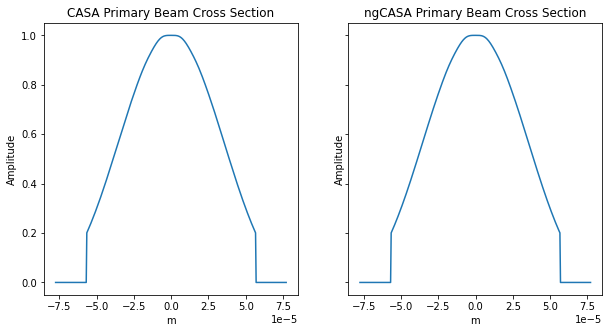
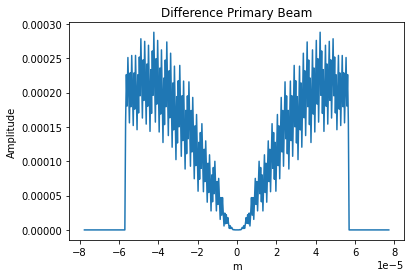

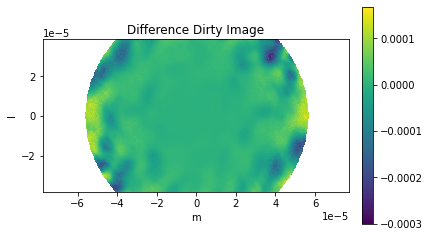
Max Normalized Error 0.0005570343301252167
RMS Normalized Error 0.011389306569008918
The difference in primary beam is due to CASA using a sampled 1D function while ngCASA calculates the PB for each pixel. If it is found that PB creation becomes a bottleneck for ngCASA the implementation will be changed to match CASA.